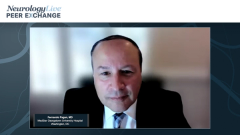
Pathophysiology of Dyskinesia in Parkinson Disease
Drs William G. Ondo and Robert A. Hauser discuss the understanding of pathophysiology and clinical features of dyskinesia in patients with Parkinson disease.
Episodes in this series

Daniel E. Kremens, MD, JD: I want to shift the conversation and start to focus on dyskinesia in Parkinson disease. Dr Ondo, can you give us the 20,000-foot view of dyskinesia, and then as a group we can dive in a bit more to some specific things about dyskinesia.
William G. Ondo, MD: Dyskinesia and Parkinson disease are essentially the opposite phenomenology of parkinsonism. So, someone with Parkinson disease is stiff, rigid, slow, with potentially tremor. Phenomenologically, dyskinesia is usually loose, hyperkinetic, and they tend to be more chorea type movements that can affect any part of the body. Typically the worse side of the Parkinson disease is also the worse side of the dyskinesia. Sometimes it may also look like dystonia, where you get some flexion, most commonly of the wrist. But I want to make an important point in that the dystonia in dyskinesia is usually painless, in contrast to painful dystonia, which is much more likely to be OFF time, an extreme form of rigidity. They may superficially look alike, but they feel very different to the patients. It’s a hyperkinetic movement that is associated with the use of dopaminergic medications. We’re going to get into more detail about pathophysiology, which I’ll say up front as a spoiler is not entirely understood.There are 2 key clinical features to dyskinesia, one, it’s associated with dopaminergic medications, and the preponderance of evidence suggests that the fluctuations and levels of levodopa and dopamine in the brain are a risk factor for drug-induced dyskinesia. We think a continuous level of dopamine in the brain is somewhat protective against dyskinesia, although that’s sometimes an easier thing said than done.
The other important feature about dyskinesia is the patient component. When patients develop symptoms of Parkinson disease they’ve lost roughly 50%, 60% of their dopaminergic neurons, but you still have 40% or 50% left. When you take these dopaminergic medicines, it’s thought that they are taken up into those residual neurons and buffered, and then released in a physiologic manner the way it’s supposed to be. Which is why a person early in the disease, despite the same doses of levodopa, which is the main cause of dyskinesia, will not be having dyskinesia because they don’t seem to have this excessive amount of dopamine. Whereas someone 10 years into the disease, where they’ve now lost 98% of their dopaminergic neurons and have no buffering capacity, will now have this excessive dopaminergic tone at the receptors and develop essentially the opposite of Parkinson disease, this hyperkinetic movement disorder.
Daniel E. Kremens, MD, JD: Dyskinesia, we didn’t see it in the predopaminergic era. This is something that has emerged with the development of medications for Parkinson disease. Bob, Bill gave a bit of a highlight there, so I’ll throw you the tough question, which is do you want to take a stab at the underlying pathophysiology of dyskinesia? I don’t know that anybody really knows.
Robert A. Hauser, MD, MBA: I think that’s right, Dan. When I try to put together a lecture and a set of slides, there are so many changes that go on. It’s hard to say this is the answer. We know that young patients are a greater risk. It’s clear that individuals who’ve been on higher doses of levodopa and for longer are at increased risk. There’s also information that suggests it relates to the up and down of dopaminergic stimulation; the so-called discontinuous or intermittent stimulation of postsynaptic dopamine receptors plays a very important role. It’s fair to say that this is a sensitivity to dopaminergic stimulation. It develops over time in patients who, A, are at risk, and, B, who are exposed to these medications, particularly levodopa. I think that’s as far as we can say with good certainty at this time, and that’s where I’ll leave it.
Daniel E. Kremens, MD, JD: Perhaps it may involve glutamatergic and serotonergic pathways as well. Do you think we can say that?
Robert A. Hauser, MD, MBA: Yes, and many other pathways in addition, absolutely.
Transcript Edited for Clarity
Newsletter
Keep your finger on the pulse of neurology—subscribe to NeurologyLive for expert interviews, new data, and breakthrough treatment updates.




































